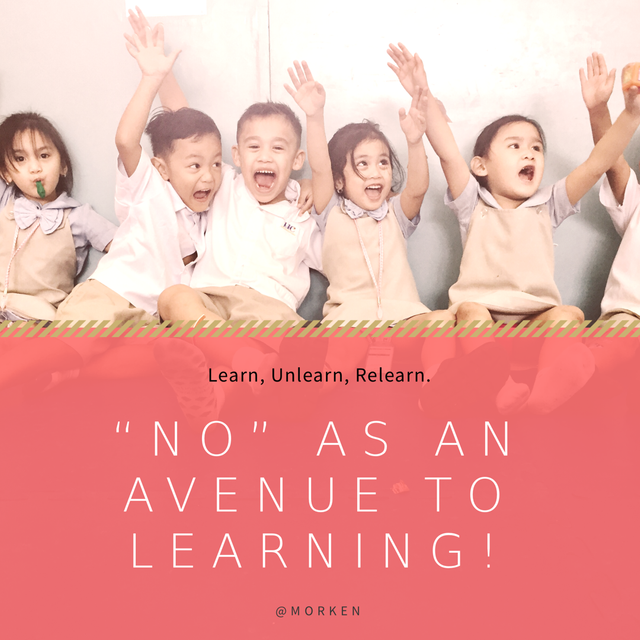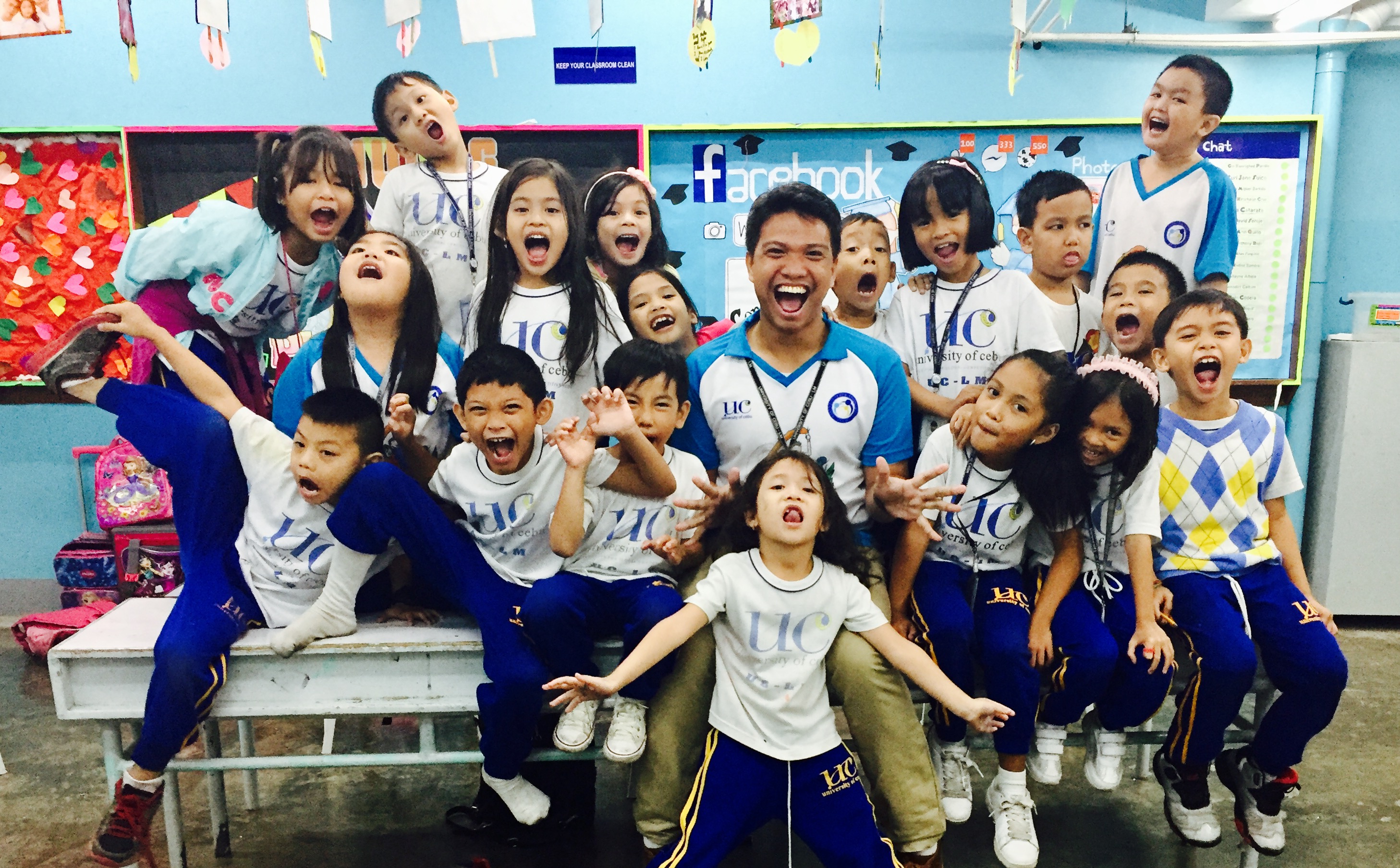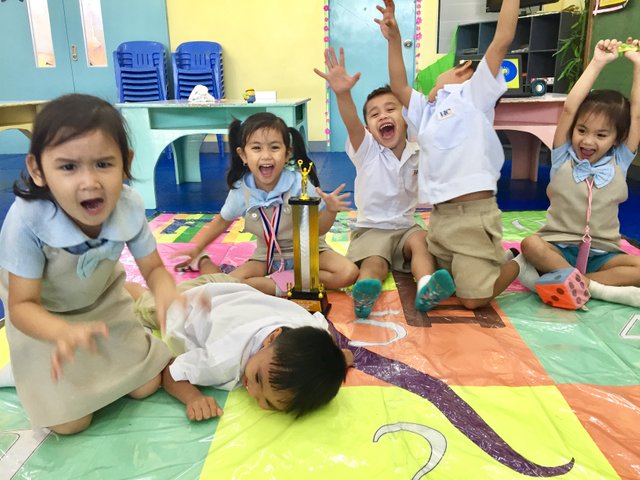Using “NO” as an Avenue to Child’s Learning
We all know how unpleasant it is to hear “NO” from somebody like when you court someone, when you ask your mom and dad that you want to hang out with your friends, when you ask your friend to do you a favor, when you proposed business to a big prospect: imagine how painful it is to receive a “NO”.
We can’t deny the fact that adult like us are even hurt by hearing the word “NO” because it is someone associated to rejections. Though adults may feel awful after receiving such word, let us now imagine how more awful it is to children.

As a little background, child development is really a crucial thing. They have normal child behaviours that an adult or a teacher needs to correct.
One of those normal behaviour is Egocentrism. This is a characteristic of a child to see himself as the center of the universe which means, he always think that he is correct. All of the things that he will be thinking will always be correct. This characteristic must be handled properly, if not, there is a possiblity that the child maybe dominant in their family, friends and even to society.
The development of a child will never happen overnight that means, you cannot force your 6 months old baby to take away egocentrism in his system. Based on my experience, it is appropriate to correct this characteristic at the age of 2-5. This can be validated with the maxim that we need to start nourishing seedlings because we can never change abnormalities in a tree.

In teacher education curriculum, we are taught to a many Principles of Learnings and one of the principles that we must understand is: Learning is a painful process.
Painful processes happens when an individual unlearns what has been learnt. Let me start relating this one to your lovelife.
It is always hard for you to move on especially when he told you that he is not loving you anymore!
Unlearning that love is the hardest thing that is why it is not easy to move on. The process is painful but you need to learn it that he is not loving you anymore, learn it that you must not also love him, and relearn to love to another person.
The process is the same to an egocentric child who sees punching his classmate is correct, for example.

How to Utter the Word “NO”
When you say “NO” don’t leave your child hanging as to why you are saying it especially to a 2-4 year old child. This can be realized by following this lovely and easy 7 steps.
- Let them speak
When a child shows his egocentric behaviour, let them speak first.
- Listen and understand
While the child is speaking, it is your duty to listen and understand. Do not interrupt him because that will make him think that you are not willing to help him. This might be the cause of rebellion.
- Decide
After listening to a child, you must decide whether you say “YES” or “NO”. This is now the crucial part because the you will never know what will be their reaction. “Yes” is always pleasant while “No” is always the opposite.
- Let them React
If you say YES to a child, he may be exclaiming because of happiness, you will see him jumping and jumping while saying yehey! Thank you mommy, thank you teacher! I love you so much! But when they here the opposite expect to hear and see unpleasant reaction.
- Don’t React
When the child reacts unpleasantly to a “NO” it is justifiable that you must not react. Let him cry a river or even shout. If you are in a public place, I highly suggest that you’ll proceed to an area that has a little people where you can also sit down together.
- Insist
You must insist that he must follow the word ”NO” especially when you have uttered it out already. If you happen to change it once, the child will eventually think that he has the command until he will dominate and practice an unpleasant behaviour.
- Talk
You talk but don’t explain your side. Let him explain his. A good talk with a child always starts with a question and ends with a question.
Below is the set of questions that I usually ask my kids when they are cry because of a “NO”:
- Why are you crying?
- What did you do?
- Are you doing the correct thing?/ Is that correct?
- Why did I say no?/ Why I get mad on what you did?
- Will you do it again?
- What will you do next time?
- Are you now a very good kid?
Those questions, you will help them realize that everything that they have done is not correct and may lead them to something even more unpleasant. Asking questions will help them assess themselves. Children are genius and it is your duty to help them get their intelligence from the cabinet of their brain.
It is always effective not to hug them while they are crying. That will lead them use their EMOTIONS and not their MINDS.
After those questions is another set of questions. This time, you let them use their emotions already.
- Do you still want to cry?
- Are you still angry/ sad?
- Do you want a hug?
That was so lovely to see when a child will seek for a comfort after crying. This time, you let them cry if they still want to. This will help them clear out the pain inside their heart.

The right time to say “NO”
Saying “no” must be appropriately delivered to a child because sometimes, a “no” can also hinders learnings. Right now, I will be sharing to you as to when would be the best time to say “no” to a child.

When they insist to change the rules like not returning the toys into the proper places. Remember that when you have said NO you must insist! Don’t change your decision.
When it hurt other people. Eliminating egocentrism in their system will help them relate to others and to the world. You must say no when it will hurt other kids already. This is really important because neglect of doing this may lead to worst cases like bullying.
When it will hurt him. This case is a separate one. Simple hurt is fine especially when the result is a total learning. Say no when it is between life and death like for example, eating foods that will trigger his allergies or playing sharp objects, and the likes.
When they think that they are correct. This will always boil down to this thought. I will let you evaluate their actions if they are still doing the right thing. If not, then decide.
The four situations given above was chosen as the top 4 events which usually happen in my class. When there are situations or scenarios happen aside from the given I advice you to do the 7 steps on how to utter “NO” immediately.

Closing Remarks
Let us always remember that we have a big part to the development of our children. The traditional way of correcting them like using sticks and hands will never be useful in this generation.
Let them assess their actions so that they can understand and always remember that our ACTIONS that they always see will be their STANDARDS. So another way to teach them good behaviours and attitude is to be an example by upholding the universal principle: Doing the Right Thing!.
Lastly, unpleasant “NO’s” are not always unpleasant if it was just delivered appropriately. Saying NO is also an avenue to learning which equates the function of saying YES.
I thank you so much in dropping by in my blog! I hope to share more my experiences to all of you!
Lovelots,

woaaaah ka cute sa mga bata! Grade 1 imong gipang handle sir morks?
Actually problema kaayo ni namo sauna sa akong pag umangkon, basta ingnan ug dili, muhilak dayun nya mu give in dayun akong papa sa iyang request. Hantud naanad na nga once muhilak hatagan dayun para dli muhilak, pero eventually, nausab rapud katong nidako2 na, makasabot ragyud na sila ug sturyaan ug tarung
Hae @smaeunabs... substitute teacher rako anang tayma maong na close nako ang Grade 1. Ako advisory kay playgroup then I am also handling Grade 2 and Grade 6.
Wow! That’s good to hear nga na correct iyang behaviour...
murag ugtas gyud kaayo ba basta grade 1 hahahah pero sure ko lingaw sad maski badlungon, mga cute man sad kaayo oy dmd. Laking gatas! hahahah
Hahahahahah... ugtas jhud to the maximum level and the challenge is we need to maintain the maximum tolerance... hahahaha
You have been upvoted by the @sndbox-alpha! Our curation team is currently formed by @jeffbernst, @bitrocker2020, @jrswab & @teachblogger . We are seeking posts of the highest quality and we deem your endeavour as one of them. If you want to get to know more, feel free to check our blog.
Thank you so much @sndbox-alpha! Keep inspiring!